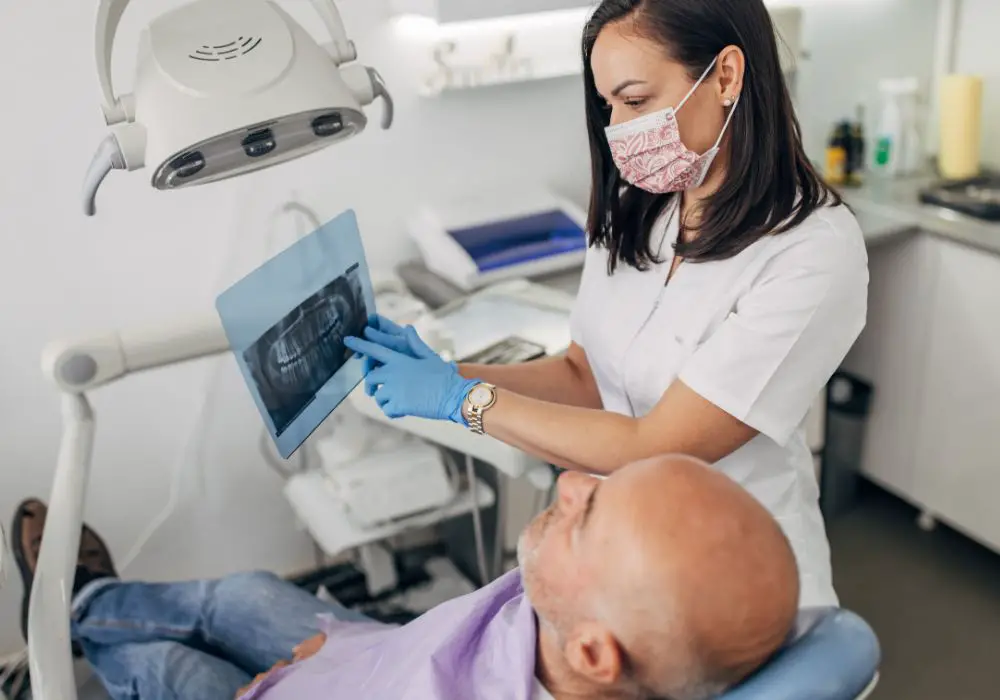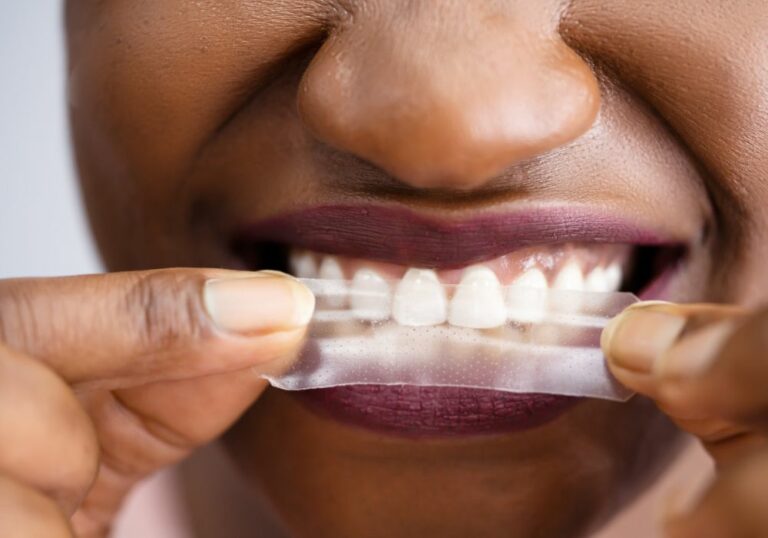Having pieces of your teeth unexpectedly break off can be alarming. This article explores the various reasons why you may be experiencing tooth fractures, steps your dentist will take to diagnose the cause, possible treatments to restore damaged teeth, and most importantly, how to prevent further tooth breakage.
What’s Causing My Teeth to Break?

Teeth are composed of an outer enamel layer, with underlying dentin and an inner pulp chamber. While enamel is quite strong and durable, it can become weakened and prone to chipping and fracturing from various factors:
Tooth Decay
Tooth decay, or dental caries, is one of the most prevalent reasons for tooth breakage. Decay occurs when plaque bacteria on the teeth produce acids that break down and demineralize the enamel. This causes cavities to form, which start shallow but can penetrate deeper over time into dentin and even the pulp.
As a cavity enlarges, it undermines the enamel structure. Weakened enamel is more likely to fracture off, especially when exposed to normal biting forces during chewing. Breakage tends to occur at the thicker outer edges or cusps of the tooth crown.
Decay can occur anywhere, but is more likely in plaque-prone areas:
- Along the gumlines
- In between teeth
- In pits and fissures of molars
Consuming sugary and starchy foods feeds the plaque bacteria and accelerates the decay process. Frequent snacking and sipping sugary drinks promotes prolonged acid attacks. Not properly removing plaque daily with brushing and flossing allows decay to initiate and worsen.
Those most at risk for cavities leading to tooth fractures include:
- Children and teens with poor oral hygiene
- Elderly adults with receding gums and root exposure
- People with dry mouth conditions
- Those with orthodontic brackets that retain plaque
- Individuals with high sugar diets
Cracks and Fractures
Cracks or fractures within the tooth structure greatly weaken it and make pieces prone to breaking off. Causes include:
Trauma
A direct blow or injury to the mouth can fracture teeth. Sports accidents, falls, and physical altercations are common causes of dental trauma. Even biting on hard foods like popcorn kernels or hard candies can crack teeth.
Grinding and clenching place excessive forces on teeth and commonly cause hairline cracks to form. These cracks start small but propagate over time until segments of the tooth fracture.
Defective Fillings
Old, defective dental restorations like fillings and crowns develop cracks and leaks, allowing new decay to form underneath. As the decay spreads, chunks of the tooth can break off along with the restoration. Amalgam fillings also undergo expansion forces that can progressively crack teeth.
Large Fillings
Teeth with extensive fillings or crowns have less remaining natural tooth structure. The higher ratio of restorative material makes them weaker and more prone to fracture. Breakage frequently occurs at the margins between tooth and filling.
Root Canals
Root canal treatment leaves teeth more brittle and susceptible to fracture since the inner pulp tissue and fluid are removed. The dehydration makes them more likely to crack under pressure. Breakage is a common late complication.
Advanced Tooth Wear
Over time, enamel can wear away from sources like:
- Acid erosion from frequent consumption of acidic foods and drinks
- Abrasion from improper brushing techniques
- Attrition from grinding or excessive chewing forces
As more enamel loss occurs, the softer underlying dentin becomes exposed. Dentin lacks enamel’s strength and is more likely to chip and fracture off. The teeth become progressively shorter, thinner, and weaker.
Age-Related Changes
Teeth tend to become more brittle and fracture-prone with age. Enamel can thin, while dentin loses some mineral content and moisture. The teeth become more vulnerable to breakage, especially if already compromised by decay or previous restorations.

Developmental Conditions
Some individuals may have tooth anomalies that predispose them to fracture:
- Hypocalcified enamel – Thinner, weaker enamel
- Enamel hypoplasia – Defective enamel formation
- Dentinogenesis imperfecta – Weak dentin prone to breakage
- Amelogenesis imperfecta – Poorly formed enamel
Parafunctional Habits
Habits like:
- Bruxism: Grinding or clenching
- Chewing on pens, nails or lip biting
Place excessive pressures on teeth. Over time, this can fracture the enamel and lead to breakage. Chunks of teeth are more likely to chip off.
Fluorosis
While fluoride protects teeth, mild to moderate fluorosis can increase enamel porosity. The higher mineral content also makes enamel more brittle. This combination can increase fracture risk.
Medications
Some medications reduce saliva flow, including:
- Antihistamines
- Antidepressants
- Muscle relaxants
- Stimulants
Saliva’s buffering and remineralizing properties help strengthen teeth. With inadequate saliva, teeth become weaker and more fracture-prone.
Warning Signs a Tooth May Crack
Look for the following signs that may indicate an underlying tooth crack and increased chance of breakage:
Temperature Sensitivity
As a crack penetrates enamel into the dentin layer, the tooth becomes sensitive to hot and cold stimuli. Nerves are more exposed through the crack defect.
Pain While Chewing
Chewing and biting force exacerbate the crack, causing discomfort and pain. The fractured segments move slightly, stimulating nerve fibers.
Unexplained Tooth Discomfort
You may notice odd, intermittent tooth pain that arises on its own and then goes away. This can indicate a crack, as movements open and close the fracture gap.
Visible Crack on Tooth Surface
Look carefully for thin cracks or fissures along the biting edges of front teeth or the cusps and crevices of back teeth. The lines may extend down the side surfaces.
Chunk of Tooth Breaks Off
You may suddenly notice a piece of a tooth chipping off while eating or brushing. This suggests a crack already existed and has now fragmented.
Don’t delay treatment for suspected cracks, as they tend to worsen until the tooth fully breaks. See your dentist right away if you notice any concerning symptoms or fracture lines. Timely intervention can help prevent extensive tooth breakage.
How Dentists Diagnose Broken Teeth

When examining and diagnosing the cause of your tooth breakage, your dentist will:
Visual Exam
- Check for any visible cracks, fractures, or decay along the broken surface and surrounding areas.
- Determine if additional fragments are loose or ready to break off.
- Assess old restorations for defects, leakage or cracks extending into the tooth.
Probe the Area
- Use a sharp dental probe to feel for any soft decay in the broken region.
- Check for crack lines that catch or deflect the probe tip.
- Assess if there are soft spots, painful areas, or movement in fragments.
Bite Evaluation
- Examine your occlusion and have you bite down, looking for problems.
- Check for malocclusion, excessive biting forces, bruxism patterns, etc.
X-rays
- Take radiographs to uncover hidden problems like subsurface cracks, decay under old fillings, or damage to underlying tooth structures.
Percussion Test
- Gently tap the tooth to test for discomfort, which would indicate cracks extending to the pulp.
Assess Gum Health
- Check for periodontal disease, which weakens tooth roots and supporting bone, increasing fracture susceptibility.
- Evaluate for adequate keratinized gingiva around the tooth, which protects against root sensitivity and decay.
Review Medical History
- Note any conditions or medications that reduce saliva flow and could dry out, weaken teeth.
- Consider developmental disorders associated with weak enamel or dentin.
Let your dentist know of any mouth injury, pain symptoms before breakage, or parafunctional habits like grinding. Thorough diagnosis identifies the exact cause so the optimal treatment approach can be planned.
Possible Treatments for Broken Teeth
The treatment required depends on factors like how much tooth structure remains, pulp involvement, and location of the break. Options include:
Dental Bonding
For minor chips confined to the enamel, dental bonding can quickly restore shape and smoothness. The dentist applies a tooth-colored composite resin material that hardens with curing light. The bonded restoration is then shaped and polished to match the tooth.
Bonding is affordable and often a good temporary fix for small fractures. However, bonding is not as strong or durable long-term compared to other restoration types. It may need replacement every 5-7 years.
Dental Veneers
Veneers provide a more permanent fix for mild to moderate chips and cracks, protecting the tooth from further damage. These thin porcelain or resin shells bond over the front of teeth. Veneers can preserve up to 50% of natural tooth structure.
Dental Crowns
When more significant portions of the tooth have broken off, a crown provides full coverage protection and strength. It caps the entire visible portion of the tooth. Crowns are needed when at least 50% of tooth structure remains.
The dentist files down the damaged areas, then takes impressions to fabricate a custom crown restoration of porcelain-fused-to-metal, ceramic, or zirconia material. This completely seals and reinforces the fractured tooth.
Root Canal
If the inner pulp chamber becomes exposed by the broken segment, root canal treatment is required to save the damaged tooth. The nerve tissue is removed and interior canals cleaned and sealed. A crown is placed afterwards to protect the now more brittle tooth.
Tooth Extraction
For severe, unrestorable fractures involving the tooth roots or alveolar bone, extraction may be necessary. As long as adequate bone remains, the missing tooth can potentially be replaced with an implant, bridge, or removable partial denture.
Promptly restoring damaged teeth prevents additional wear, decay, and breakage. Even significantly fractured teeth can often be salvaged with proper crown treatment.
How to Prevent Tooth Breakage

While fractures sometimes happen spontaneously, you can reduce your risk by taking these preventive measures:
Practice Excellent Oral Hygiene
- Brush properly twice daily with a soft-bristle or electric toothbrush. Use a fluoride containing toothpaste.
- Floss at least once daily to clean between teeth.
- Rinse daily with an antiseptic mouthwash to reduce plaque bacteria.
Thorough hygiene minimizes decay development that weakens tooth structure.
Get Regular Dental Cleanings and Checkups
- See your dentist every 6 months for professional cleanings to remove plaque buildup and spot problems early.
- Have dental exams to check for emerging cracks, defective old restorations, and signs of occlusal wear.
Wear a Nightguard if You Grind Teeth
Custom nightguards help prevent the cracks and fractures caused by bruxism. Wear each night during sleep to protect your teeth from grinding forces.
Avoid Chewing Ice, Hard Candy, Bones Etc.
Avoid crunching on hard foods that can crack teeth and damage dental work. Stick to softer foods that are less likely to fracture teeth.
Use a Mouthguard During Sports
Mouthguards cushion blows that might otherwise fracture teeth and cause dental injuries. Wear one for both contact sports and activities like skateboarding or skiing.
Monitor Sugary Snack Habits
Frequent snacking boosts acid attacks on teeth. Limit sugary treats and choose tooth-friendly options like cheese, vegetables, nuts or sugar-free gum.
Drink Water and Reduce Acidic Beverages
Water helps neutralize acid and wash away food particles. Minimize intake of acidic drinks like soda, juice, wine, and sports drinks that erode enamel.
Don’t Chew Pens, Pencils or Other Objects
Avoid using your teeth as tools. Chewing on non-food items can crack teeth and fillings. Replace the habit with chewing gum instead.
Get Prompt Treatment for Decay
Don’t delay fillings for cavities. Unrestored decay undermines enamel strength and makes fractures more likely.
Check Old Fillings and Crowns
See your dentist if an old restoration develops cracks, pain, or hot/cold sensitivity. Defective restorations need replacement to avoid further tooth damage.
With diligent oral care and regular dental visits, you can keep your teeth strong and intact. But some fractures still occur despite good prevention. Seek prompt care for any cracked or broken teeth to minimize additional loss.
Frequently Asked Questions
1. Should I see my general dentist or a specialist for a cracked tooth?
General dentists can provide most treatments for cracked teeth, including fillings, crowns, and extractions. However, if the crack extends into the root and pulp necessitating a root canal, you may be referred to an endodontist who specializes in this treatment.
2. How can I temporarily relieve pain from a cracked tooth at home?
Taking over-the-counter pain medication like ibuprofen can provide temporary relief until you can see a dentist. You can also rinse with warm salt water and avoid chewing on the affected side. But seek professional treatment promptly, as cracks tend to worsen over time.
3. What are the signs my tooth crack has become infected?
Signs of infection from a cracked tooth extending into the pulp include throbbing pain, tooth sensitivity, swelling of the gums around the area, and pus discharge. This requires urgent dental care, as infection can spread and become serious.
4. Can dental veneers be used to restore a fractured front tooth?
Yes, as long as at least 50% of the original tooth structure remains, veneers are a great option for repairing chips or cracks in front teeth. The thin porcelain covers reinforce the tooth and stop fractures from extending.
5. How do crowns prevent further cracking compared to bonding?
Crowns fully envelop the entire tooth with a complete coverage restoration of ceramic, porcelain, or gold material. This provides superior reinforcement compared to direct composite resin bonding. Crowns are recommended for cracks extending beyond the enamel into dentin.
6. Why can’t fractures involving the tooth root or bone be restored?
The roots help anchor the tooth in bone. If seriously involved in the fracture, the remaining tooth portion may be too unstable to save. Extensive damage extending into supporting bone also makes restoration infeasible, hence extraction becomes necessary.
Final Thoughts
Pieces of your teeth breaking off can certainly be disturbing. But don’t panic – many fractured teeth can be successfully restored with modern dental treatments. Prompt evaluation allows early intervention before the damage progresses further. Practicing ongoing prevention and avoiding harmful habits are also key to maintaining your teeth strong and intact.







